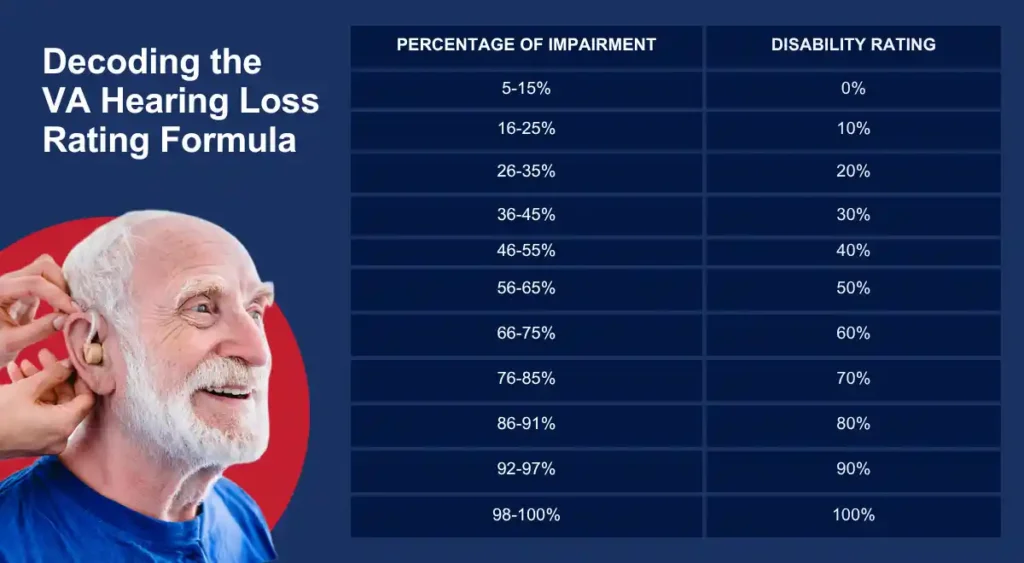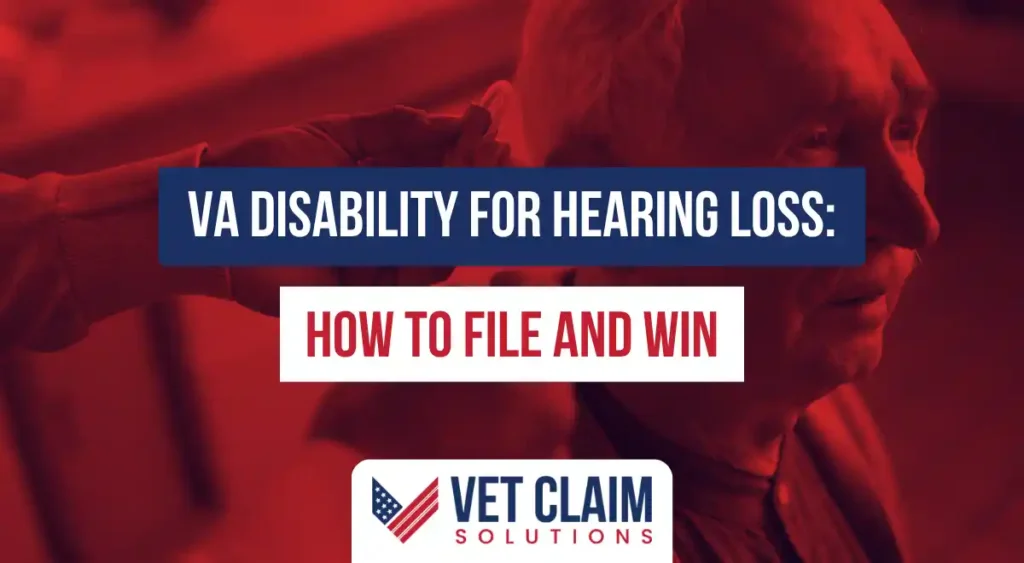Is the world starting to sound muffled? Do you find yourself constantly asking people to repeat what they said? You are not alone. So many veterans leave the service with their hearing damaged, and if you are struggling to hear, learn how the VA rates hearing loss, common evidence needed and tips for a successful claim right here.
The constant ringing, the missed conversations, the frustration of turning the TV volume way up—it takes a toll. You served your country, and the exposure to military noise was just part of the job. But now, it affects your everyday life.
This guide will walk you through the process for your VA claim. It’s about getting the VA benefits you rightfully earned for your sacrifice. You’ll learn exactly how this all works so you can confidently file your loss claim.

Understanding Service-Connected Hearing Problems
Before filing a hearing loss claim, you need to know about two common conditions veterans face: hearing loss and tinnitus. The VA sees them as separate issues, so you can file a claim for one or both. Think of hearing loss as difficulty hearing sounds, while tinnitus is that persistent ringing, buzzing, or hissing sound in your ears.
To get VA disability benefits, you have to show your hearing problem is a service-connected condition. This just means your military service caused or made your condition worse. Think back to your time in the service and all the loud noises you were around.
Perhaps you worked on a flight line, in an engine room, or spent hours on the gun range. These are all examples of in-service events that can lead to permanent hearing damage from loud noise. Documenting that exposure is a big part of your VA disability claim.
There are three main types of hearing loss you might experience.
- Conductive Hearing Loss: This type of hearing loss happens when sounds cannot get through the outer or middle ear. It can be caused by things like fluid, ear infections, or damage to the eardrum or the small bones in the middle ear. Sometimes, conductive hearing problems can be corrected with medical or surgical intervention.
- Sensorineural Hearing Loss: This is the most common type of hearing loss for veterans. Sensorineural hearing issues stem from damage to the inner ear or the nerve pathways from the inner ear to the brain. Exposure to loud noise is a primary cause of sensorineural hearing loss, which is typically permanent.
- Mixed Hearing Loss: As the name suggests, mixed hearing loss is a combination of both conductive and sensorineural hearing issues. This means there is damage in the outer or middle ear as well as the inner ear or auditory nerve. A veteran might have sensorineural hearing loss from noise exposure and also a conductive hearing issue from a separate injury.

How the VA Rates Hearing Loss for Disability Benefits
The VA has a very specific way of measuring and providing a loss rating. It’s not as simple as just saying you can’t hear well. They use a couple of tests and a mathematical formula to figure out your disability percentage and the VA rates hearing problems based on these results.
How the VA Tests Your Hearing
When you file a claim, the VA will likely schedule you for a Compensation & Pension (C&P) exam with a licensed audiologist. This exam is a critical piece of your hearing loss va claim. The audiologist will perform key audiometric testing to measure exactly how well you hear.
The first part is the Pure Tone Audiometry test, also known as a tone audiometry test. During this audiometry test, you’ll sit in a soundproof booth and wear headphones. The audiologist will play a series of beeps at different frequencies and volumes, and you just signal when you hear one.
This pure tone audiometry test finds the quietest sound you can possibly hear, known as your puretone threshold, at various pitches. The VA is particularly interested in your hearing ability at the 1000, 2000, 3000, and 4000 Hertz (Hz) levels. These frequencies are most important for understanding human speech.
The second test is a speech discrimination test, officially called the Maryland CNC test. For this CNC test, you will listen to a list of 50 one-syllable words and repeat them back. This shows the audiologist how well you can understand speech in a quiet setting, and the results of this Maryland CNC test are crucial for the VA’s rating va formula.
It’s important to be completely honest during these tests and for the audiologist explain anything you do not understand. Don’t try to guess or “tough it out” because you think it will help. The results of these exams are what the VA rater will use to calculate your disability compensation.
Decoding the VA Hearing Loss Rating Formula
The VA’s method for hearing loss ratings can feel a bit confusing. It’s not a direct scale. They use the results from your pure tone audiometry and speech discrimination tests and plug them into a numeric formula based on guidelines in the Code of Federal Regulations, specifically 38 CFR § 4.85, using what is called Table VI.
The audiologist calculates a threshold average for each ear based on the puretone threshold results. This average is then used with the Maryland CNC test score on Table VI to find a Roman numeral designation for hearing impairment. That Roman numeral corresponds to a percentage, which is then used to calculate your final bilateral hearing loss va rating.
It sounds like a lot, and it is. The important thing to know is that it takes a significant level of measured hearing loss to get a higher rating than 0% or 10%. But don’t let that stop you from pursuing your hearing loss condition claim.

A 0% loss va rating is actually a win. It means the VA acknowledges that your hearing loss is connected to your service. This is called establishing service connection, and it makes you eligible for VA healthcare, including high-quality hearing aids at no cost to you.
The 10% Rating for Tinnitus
Tinnitus is that ghost noise—the ringing, buzzing, or clicking that only you can hear. It’s one of the most common disabilities claimed by veterans and a frequent service-connected condition. If you have it, you should absolutely file for it as part of your VA claims.
The VA rates tinnitus differently than hearing loss. If service-connected, tinnitus is assigned a 10% VA disability rating. This percentage does not change, whether the ringing is constant or comes and goes, or if it is in one ear or both.
You can receive a 10% rating for tinnitus even if you get a 0% rating for hearing loss. They are two separate va claims based on two different conditions. Getting that 10% can be a huge first step in getting the disability benefits you’ve earned.
The Essential Evidence You Need for Your Claim
Winning a VA disability claim comes down to having the right proof. You can’t just tell the VA your hearing is bad; you have to show them. This means gathering medical evidence and statements that connect your hearing problem directly to your military service.
Proving a Service Connection (The Nexus)
For any successful claim, you need three key things. First is a current diagnosis of your condition from a medical professional. Second is proof of an event or injury that happened during your service, like consistent exposure to military noise.
The third piece is the bridge that connects the first two. It’s called a nexus. You need a medical opinion that states your current hearing condition is at least as likely as not caused by your in-service noise exposure.
For example, your Military Occupational Specialty (MOS) could be your nexus. If you were an infantryman, artillery crewmember, or aircraft mechanic, you have what’s called a high-probability MOS for noise exposure. This makes connecting your sensorineural hearing loss to your service much more straightforward.
Building Your Evidence File
Think of yourself as building a case. The more solid medical records and service records you have, the stronger your VA hearing loss claim will be. Here is a list of documents you should gather.
- Your DD 214: This shows your dates of service and your MOS.
- Service Treatment Records (STRs): Look for any mention of hearing tests, complaints about hearing, or treatment for ear infections during your time in service. Even one entry can be very powerful.
- Current Medical Records: You need a diagnosis of hearing loss or tinnitus from a doctor, ideally an audiologist, for your loss VA claim.
- Buddy Letters or Lay Statements: These are written statements from people who served with you. They can talk about the noisy environments you worked in together. Spouses can also write statements about how your hearing loss affects your daily life.
- Your Personal Statement: This is your chance to tell your story. Write down in detail the noise you were exposed to in the military and how your hearing issues affect you now. Talk about the frustration, the isolation, and the daily challenges.
- Private Medical Opinion (Nexus Letter): While the VA provides a C&P exam, a nexus letter from a private doctor can add significant weight to your claim. A private licensed audiologist can review your records and write a medical opinion linking your hearing loss to your service.

Smart Tips for a Stronger VA Hearing Claim
Filing a VA claim can feel like a lot of work, but a few simple tips can make a big difference. Going in prepared can greatly improve your chances of getting the benefits you deserve. These strategies have helped countless veterans get their va rating.
First, be completely open and honest at your C&P exam. Don’t exaggerate your symptoms, but also do not downplay them. If a sound is faint, say so, and if you can’t understand a word during the Maryland CNC test, tell the examiner you can’t understand it.
Second, clearly explain your daily struggles to the examiner. Instead of just saying “I have trouble hearing,” give concrete examples. Tell them, “I have to have the TV volume at 40 just to hear it,” or “I miss parts of conversations with my family and it makes me feel left out.”
Always file for tinnitus as a separate claim from hearing loss. Many veterans think they are part of the same thing, but the VA treats them as distinct conditions. This is a simple step that can get you a 10% VA disability rating right away.
Don’t be discouraged if you get a 0% VA rating for hearing loss. As mentioned earlier, this is a big win because it establishes a service connection. That opens the door to free, top-of-the-line hearing aids from the VA and other medical care.
Finally, think about secondary service connection. Living with hearing loss and tinnitus is hard, and the governing disability law recognizes this. It can lead to other issues like depression, anxiety, or insomnia, for which you may be able to file a secondary claim.
Conclusion
Your hearing loss and tinnitus are real, and they likely began during your time in uniform. You don’t have to just live with it. The VA benefits system is there to help veterans who are dealing with the after-effects of their service.
The path to a successful claim involves understanding the process, gathering your evidence, and clearly communicating your struggles. While it may seem complicated, taking it one step at a time makes it manageable. So if you’re struggling to hear, learn how the VA rates hearing loss, common evidence needed and tips for a successful claim and start the process.
You served honorably, and you’ve earned this support. Take that first step today. It’s time to get the help and disability compensation you deserve.


